Autism and Tics

Exploring the Intersection of Autism Spectrum Disorder and Tic Disorders
Autism Spectrum Disorder (ASD) and tic disorders are both neurodevelopmental conditions that frequently co-occur, especially in childhood. While each condition has distinct features, their overlapping symptoms and shared neurobiological pathways can complicate diagnosis and management. This article delves into the characteristics, prevalence, causes, and support strategies for tics in individuals with autism, aiming to increase awareness and understanding of these complex interactions.
Prevalence and Epidemiology of Tics in Autism
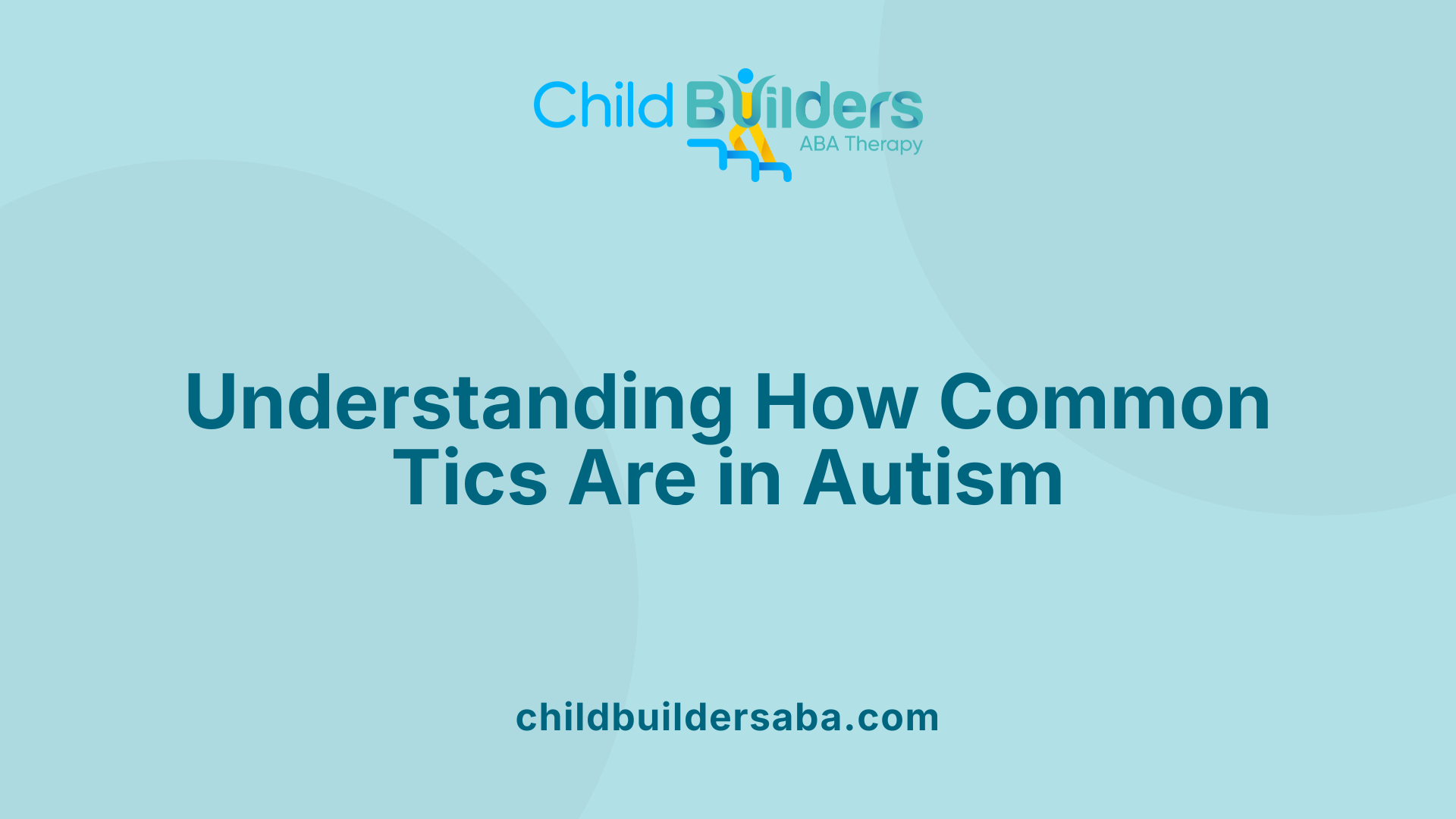
What is the prevalence of tic symptoms in individuals with autism?
Research indicates that tics are quite common among people with autism spectrum disorder (ASD). In particular, studies show that approximately 9-12% of individuals with ASD exhibit symptoms of tics, which include involuntary motor movements and vocal sounds. One detailed assessment involving 21 autistic participants found that 18.4% had tics, with many displaying both motor and vocal types. The presence of tics in autism can be persistent but varies in severity and frequency.
Most autistic individuals with tics present behaviors like eye blinking, nose twitching, throat clearing, or lip licking. These tics are often brief, fast, and repetitive, and can fluctuate over time. For example, about 40% of those with tics show both motor and vocal symptoms, indicating a significant overlap. Tics tend to be less severe and more restricted than in other neurodevelopmental conditions like Gilles de la Tourette syndrome. Adults with autism also tend to have a reduced awareness of their tics, which can make management more challenging.
How do tics in ASD compare to those in Tourette syndrome?
While tics in autism share some features with those observed in Tourette syndrome (GTS), notable differences exist. Tics in ASD are generally milder—less intense, less frequent, and involve a narrower distribution, predominantly affecting the head and face areas. The distribution pattern of tics in autism and GTS often looks similar, but the severity differs markedly.
Individuals with GTS are typically aware of their tics and may experience a premonitory urge before performing the tic—an uncomfortable sensation that prompts the action. In contrast, adults with ASD often have less awareness of their tics, which may be linked to deficits in social cognition and self-awareness commonly observed in autism.
Furthermore, tics in GTS tend to be more complex, involving multiple movements or vocalizations, while in autism, they are simpler and less disruptive. The neurobiological substrates involved, such as the basal ganglia, are common to both conditions, but differences in their clinical expression point to distinct neurodevelopmental profiles. Understanding these distinctions is essential for effective diagnosis and tailored interventions.
Characteristics and Phenomenology of Tics in Autism
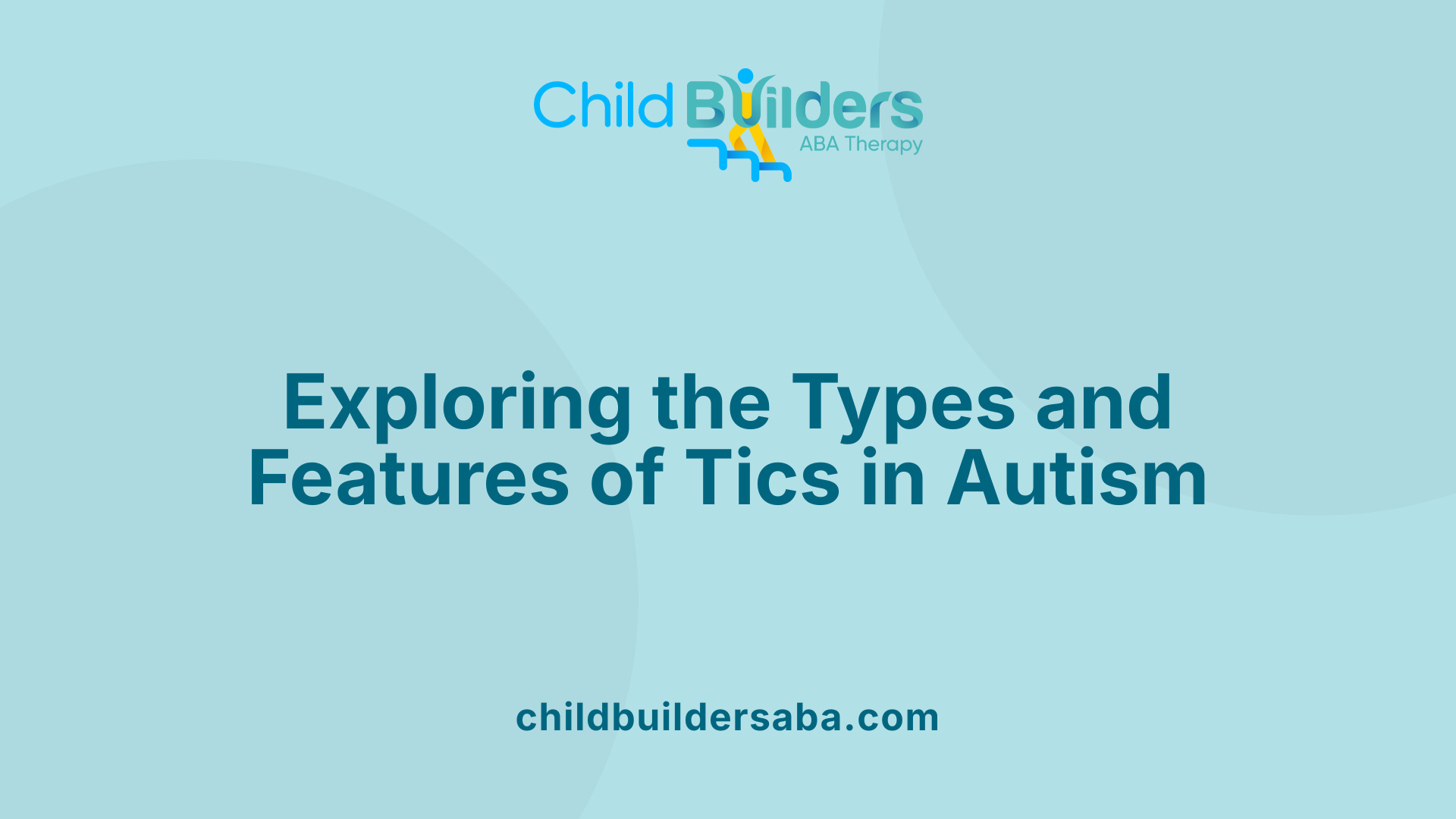
What are the characteristics and types of tics observed in individuals with autism?
Tics in autism are characterized as sudden, involuntary movements or sounds that can vary significantly among individuals. Motor tics include eye blinking, facial grimacing, shoulder shrugging, head jerking, and limb movements such as tapping or limb tensing. Vocal tics include throat clearing, humming, sniffing, grunting, and echolalia—where individuals repeat words or phrases.
These tics often emerge around ages six to eight but can start earlier or later, and they tend to fluctuate in frequency and intensity over time. The severity and frequency of tics are generally lower compared to Gilles de la Tourette syndrome (GTS). Tics in autism are often brief, rapid, and can be triggered or exacerbated by stress, fatigue, or sensory overload.
Research shows that approximately 9-12% of individuals with autism experience tics, with about 40% presenting with both motor and vocal types. The distribution of these tics is typically rostrocaudal, affecting head and face regions most commonly. Individuals with autistic tics may experience sensations or urges before performing the tic, which provides temporary relief.
How are tics differentiated from stereotypies in autism?
Differentiating tics from stereotypies involves recognizing their distinct features:
- Tics are rapid, random, nonrhythmic movements or sounds that are often preceded by premonitory urges and are involuntary, making them difficult to suppress.
- Stereotypies are rhythmic, more sustained behaviors that are voluntary or semi-voluntary and typically serve self-regulatory, calming functions.
Common stereotypic behaviors include hand flapping, rocking, lip licking, and body rocking — behaviors that are rhythmic and often goal-oriented, usually starting very early in childhood (before age three). They are often purposeful or self-stimulating behaviors used for self-soothing.
In contrast, tics tend to wax and wane in pattern, can appear suddenly, and are less rhythmic. They are linked to sensory urges that the individual may feel the need to perform to relieve an unpleasant sensation. Both behaviors are important to distinguish for proper management and support, as tics may interfere more with daily activities, especially if they increase in severity or frequency.
Neurobiological Causes and Underlying Mechanisms
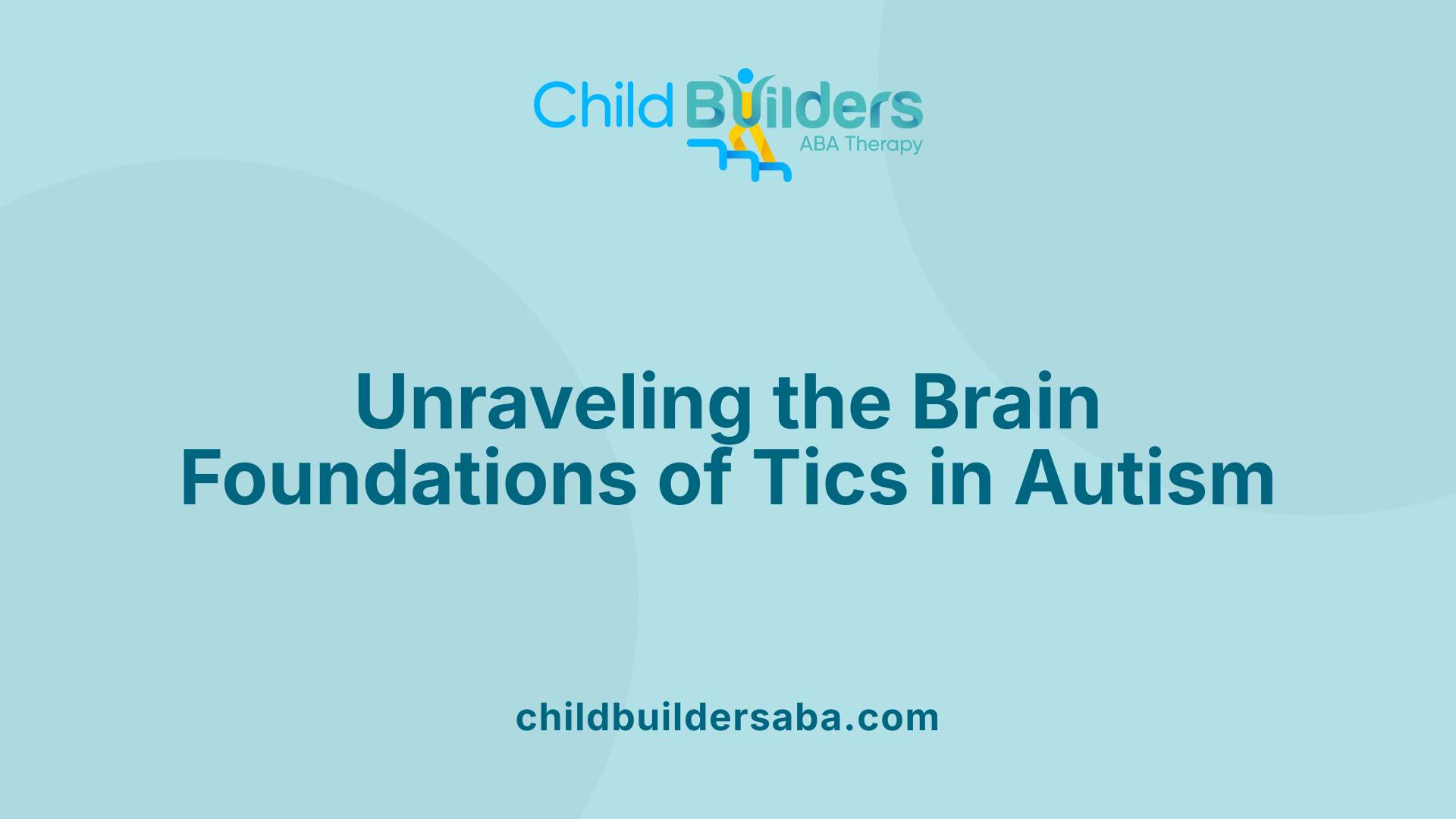
What are the causes and underlying mechanisms of tics in individuals with autism?
Tics in autism are primarily linked to neurobiological alterations involving specific brain regions that control movement and sensory processing. Central to these changes are the basal ganglia, thalamus, and frontal cortex. These areas form part of the neural circuits responsible for executing voluntary movements and filtering sensory information. Disruptions or imbalances within these regions can lead to the involuntary motor and vocal behaviors characteristic of tics.
An important neurochemical factor is the neurotransmitter dopamine. Imbalances in dopamine transmission can heighten neural activity in movement circuits, contributing to the development of tics. For example, increased dopamine activity is known to exacerbate tic severity in conditions such as Tourette syndrome, which often co-occurs with autism.
Structural differences in the brain, including abnormal development or functioning of the corticostriatal pathways, distort the normal regulation of movement, thereby facilitating tic behaviors. These pathways connect the cortex with the basal ganglia, playing a vital role in motor control.
Genetics also play a critical role. Tic disorders like Tourette syndrome show high heritability, with estimates nearing 90-94%. This indicates a significant genetic contribution to the neurobiological basis of tics. Studies have identified various genetic markers that predispose individuals to develop tics, many of which overlap with those associated with autism.
Environmental factors can influence tic severity and occurrence. Stress, fatigue, and sensory overload—common in people on the autism spectrum—can trigger or worsen tics. These environmental triggers interact with the underlying neurobiological vulnerabilities, leading to more prominent symptoms.
Overall, tics in autism arise from complex interactions between structural brain anomalies, neurochemical imbalances, genetic predispositions, and environmental influences. These factors disrupt the normal cortico-basal ganglia-thalamic circuitry, resulting in involuntary movements and sounds.
How does the neurobiology of Tics relate to autism?
Both autism and tic disorders share common neurobiological substrates involving the corticostriatal pathways, which play a crucial role in motor control and sensory regulation. Abnormalities in this circuitry are found in both conditions, leading to overlapping symptoms such as involuntary movements and sensory fluctuations.
The basal ganglia, a collection of subcortical nuclei, are particularly important. In both autism and tics, abnormalities here—such as increased activity or structural differences—are associated with difficulties in controlling movements and behaviors. These neural differences can manifest as stereotypies in autism, which are rhythmic and purposeful, versus tics, which are rapid and less controllable.
Neurochemical imbalances, especially regarding dopamine, further link the neurobiology of tics with autism. Excessive dopamine activity has been implicated in the severity of tics and is also associated with certain autistic behaviors, including repetitive routines and interests.
This overlapping neurobiology explains why tics frequently co-occur in individuals with autism. It also accounts for the observation that the severity of tic symptoms can correlate with the severity of core autism symptoms and associated conditions like obsessive-compulsive disorder (OCD) and behavioral challenges. Understanding these shared pathways provides insights into targeted therapeutic strategies that might address both conditions simultaneously.
Differentiation and Diagnosis of Tics in Autism
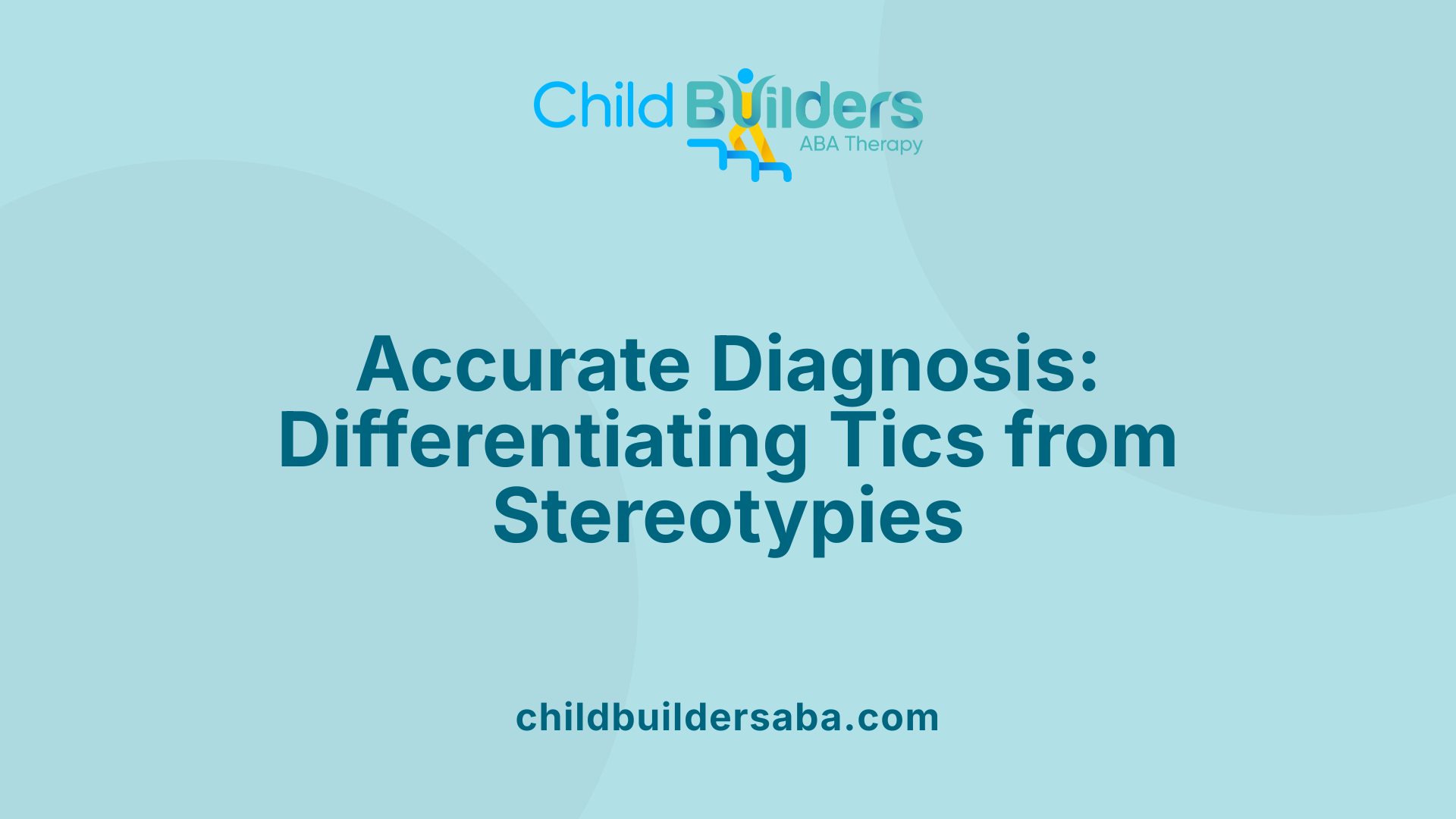
How can tics in autism be diagnosed and identified?
Diagnosing tics in individuals with autism spectrum disorder (ASD) involves a thorough clinical assessment conducted by healthcare professionals such as pediatricians, neurologists, or psychiatrists. The process focuses on examining the nature of the behaviors—whether they are movements or sounds—and their characteristic features. Tics typically present as sudden, brief, repetitive, and waxing-waning behaviors that can vary in intensity and frequency.
A crucial aspect of diagnosis is identifying premonitory urges—distressing sensations like tension, energy, or discomfort that often precede a tic. Recognizing these urges helps distinguish tics from other involuntary or self-stimulatory behaviors common in autism, like stimming.
Standardized assessment tools, such as the Yale Global Tic Severity Scale (YGTSS), are regularly used to quantify and monitor tic severity, frequency, and impact on daily functioning. However, much of the diagnosis relies on careful direct observation and detailed history-taking, including reports from caregivers to understand behaviors that might not be obvious during clinical visits.
Differentiating tics from stereotypies and stimming behaviors is vital. Tics tend to be less rhythmic, more abrupt, and often involve a sense of an involuntary urge. In contrast, stereotypies and stimming are usually rhythmic, purposeful, and serve functions like self-soothing or sensory regulation.
What are the implications for assessing tic severity and awareness in ASD populations?
Assessing tic severity in people with ASD presents unique challenges. Many autistic individuals, especially adults, may have limited awareness of their tics, making it difficult to gauge how severe or disruptive these behaviors are. This reduced insight can lead to underreporting or misunderstanding of the tics' impact.
The presence of premonitory urges offers valuable insight into the involuntary nature of tics. When urges are present, it indicates a semi-voluntary aspect, which can guide targeted intervention strategies.
Tools like the YGTSS help clinicians systematically evaluate the severity and impairment caused by tics. However, because observational and caregiver reports often form the core of assessment, understanding that some individuals may not recognize or report their tics accurately is essential.
Caregiver reports are especially important when the individual’s awareness is limited. They provide contextual information about behaviors that might not be captured during clinical assessments. Recognizing the distinction between tics and stereotypic behaviors is crucial, as management approaches differ.
In summary, accurate evaluation of tics requires a combination of direct observation, standardized tools, and caregiver input. Appreciating these nuances ensures that interventions are appropriately tailored, improving outcomes for individuals with ASD experiencing tics.
| Assessment Aspect | Considerations | Additional Details |
|---|---|---|
| Diagnostic tools | Use of standardized scales like YGTSS | Quantifies severity, frequency, and impairment |
| Behavioral observation | Watching for sudden, brief movements/sounds | Distinguishes tics from voluntary actions |
| Premonitory urges | Noticing sensations before tics | Helps differentiate tics from stereotypies and stimming |
| Caregiver reports | Gathering family observations | Critical when self-awareness is limited |
| Differentiation criteria | Rhythmicity, purpose, voluntary control | Tics are less rhythmic, involuntary, often preceded by urges |
Understanding these assessment components is essential for accurate diagnosis, guiding effective treatment plans, and improving quality of life for autistic individuals with tics.
Management Strategies and Interventions
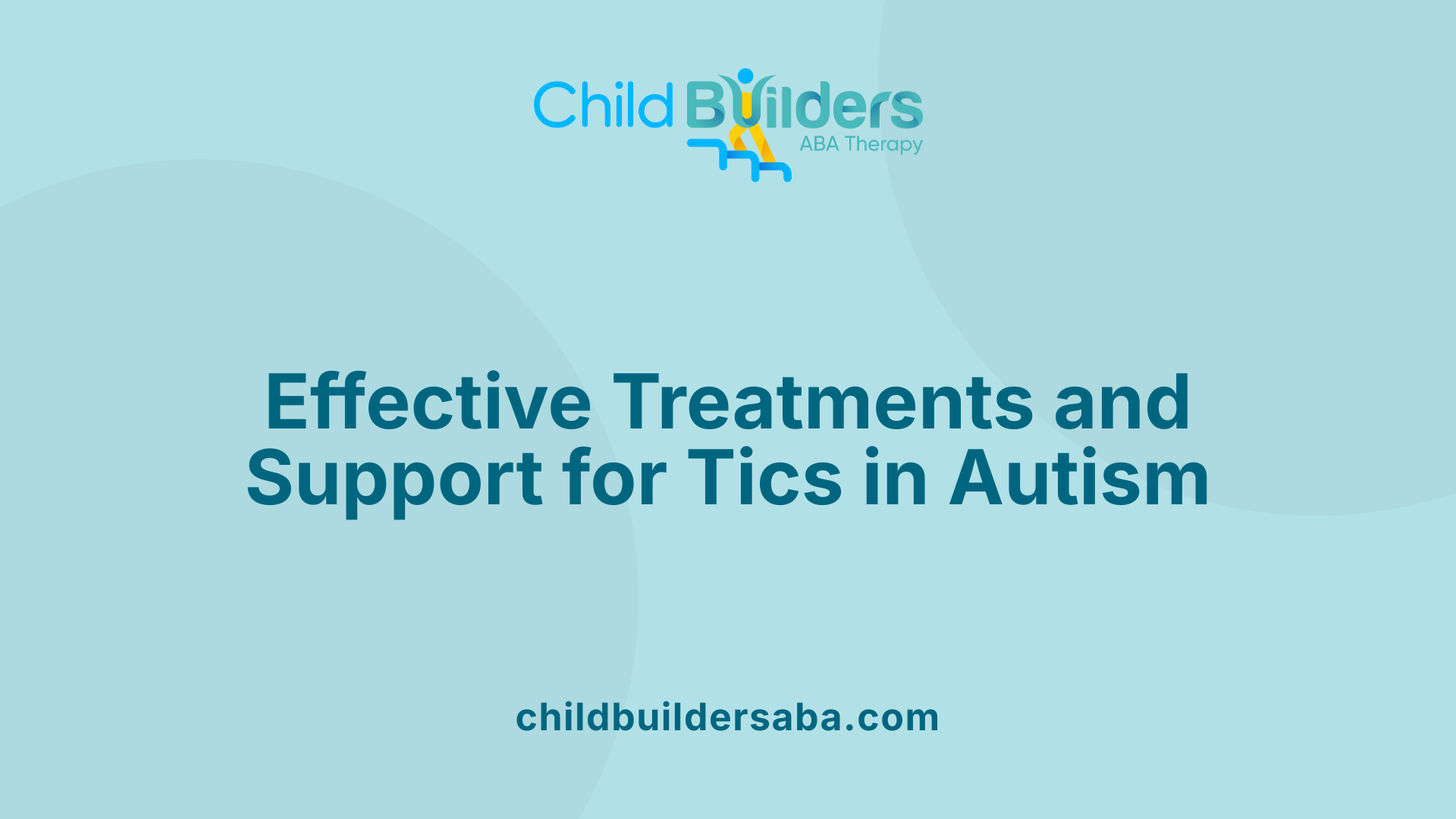
What are the treatment options available for managing tics in individuals with autism?
Managing tics in individuals with autism involves a combination of behavioral therapies, medication, and supportive interventions. Behavioral approaches such as Habit Reversal Therapy (HRT) and Comprehensive Behavioral Intervention for Tics (CBIT) are frontline treatments. These therapies work by helping individuals become more aware of their tics, identify triggers, and develop competing responses that reduce tic frequency and intensity.
Pharmacological treatments are used when tics are severe or interfere significantly with daily life. Common medications include alpha-2 adrenergic agonists like clonidine and guanfacine, which can help reduce tics with fewer side effects. In more challenging cases, antipsychotic medications such as risperidone and aripiprazole may be prescribed to manage distressing or disruptive tics. For localized or painful tics, botulinum toxin injections have shown effectiveness.
Supportive strategies are vital in providing a holistic approach. Creating calming environments, managing stress, and teaching self-regulation techniques help minimize tic exacerbation. Regular monitoring and tailoring treatment plans to include comorbid conditions like ADHD or OCD are essential for optimal management.
Overall, a personalized combination of behavioral techniques, medication, and environmental adjustments offers the best outcomes for individuals with autism experiencing tics.
How can caregivers support children with autism and tics in daily life and educational settings?
Caregivers and educators play a critical role in supporting children with autism and tics. Promoting understanding and acceptance of tics helps reduce stigma and emotional distress. It is important to avoid punishing or attempting to suppress tics, as this can increase anxiety and potentially worsen the tics.
Practical strategies include implementing visual schedules and providing sensory tools—such as stress balls or noise-canceling headphones—to support sensory regulation. Allowing sensory breaks during activities helps prevent overload and can reduce tic frequency.
Creating predictable routines and a calm, supportive environment also aid in managing stress, which is a common trigger for tics. Educating teachers and peers about tics and autism fosters empathy and encourages inclusive behavior.
Encouraging self-regulation techniques, such as deep-breathing, physical activity, or mindfulness, can empower children to manage their tics. Collaborating with healthcare professionals ensures that strategies are tailored to each child's needs, and involving families promotes consistency across home and school settings.
Support involves ongoing communication, patience, and understanding. By fostering a positive environment, caregivers and educators help children develop confidence, reduce anxiety, and improve their social and academic participation.
| Aspect | Strategies | Additional Notes |
|---|---|---|
| Behavioral Techniques | Habit Reversal Therapy (HRT), CBIT | Focus on awareness, competing responses |
| Medications | Clonidine, Guanfacine, Risperidone, Aripiprazole | Use when severe or disruptive tics are present |
| Supportive Environment | Sensory tools, routine schedules, stress management | Aims to minimize triggers and enhance comfort |
Understanding the interplay between neurobiological, environmental, and psychological factors is crucial in effectively supporting individuals with ASD and tics. Tailored interventions that combine these elements provide the best chance for improved quality of life.
Myths, Misconceptions, and Awareness
What misconceptions exist about tics and autism, and how can awareness be increased?
Many misunderstandings surround tics and autism, often stemming from a lack of knowledge about their neurological basis. A prevalent myth is that all individuals with tics engage in behaviors like swearing (coprolalia), which only about 15-20% of those with tic disorders do. Others mistakenly believe that tics are purposeful or voluntary, such as speech or movements made intentionally, rather than recognizing them as involuntary responses. Some underestimate the impact, viewing tics as superficial habits or stereotypies, ignoring their connection to brain function.
Increasing awareness involves thorough education about the involuntary nature of tics and their triggers, such as stress or fatigue. It is important to highlight that tics vary widely in severity and manifestation. Clarifying that tics can coexist with autism without being disruptive helps reduce stigmatization. Sharing accurate information about treatment options like behavioral therapies—such as Habit Reversal Therapy (HRT) or Comprehensive Behavioral Intervention for Tics (CBIT)—and personal stories can foster empathy.
Public awareness campaigns, professional training, and comprehensive educational programs are crucial strategies. These initiatives help dispel myths, inform about the neurobiological and genetic basis of tic disorders, and emphasize that tics are not deliberate. When society understands these behaviors better, it encourages acceptance and reduces misconceptions.
How does awareness about tics influence support systems for individuals with autism?
Greater understanding of tics positively impacts support structures for those on the autism spectrum. It prompts caregivers, educators, and community members to respond with compassion rather than judgment. Recognizing tics as involuntary helps prevent punitive responses that can add to emotional distress.
Increased awareness facilitates early diagnosis and intervention, enabling tailored educational and behavioral strategies that improve daily functioning. When the support system is informed, adaptations—like providing sensory breaks, creating calming environments, and teaching self-regulation techniques—become more widespread and effective.
Furthermore, widespread understanding reduces stigma, promotes societal acceptance, and encourages social inclusion. This environment helps individuals with autism and tics to develop self-advocacy skills and fosters a sense of belonging. Ultimately, awareness builds a more supportive society that values neurodiversity and recognizes the unique challenges faced by individuals with autism and tic disorders.
Fostering Understanding and Support
Recognizing and addressing the intersection of autism and tics is essential for fostering compassion, improving management, and supporting the developmental needs of affected individuals. Through continued research, education, and tailored intervention strategies, caregivers, educators, and healthcare professionals can enhance quality of life, reduce stigma, and promote acceptance of neurodiversity. Increased awareness about the neurobiological underpinnings and behavioral characteristics of tics in autism will improve diagnosis accuracy and treatment outcomes, ultimately empowering individuals to navigate their environments with greater confidence.
References
- Tic Phenomenology and Tic Awareness in Adults With Autism - PMC
- Tics in Autism: Why They Happen & What to Do About Them
- Clinical characteristics of comorbid tic disorders in autism spectrum ...
- Autism and Tic Disorders - Seattle Children's Hospital
- [PDF] Differences and similarities of ASD and Tourette Syndrome
- What Are Autistic Tics? | Psych Central
- Autism and Tics: Is There a Connection?
- Autism and Tics - Golden Care Therapy



.jpg)

































































































